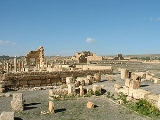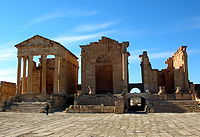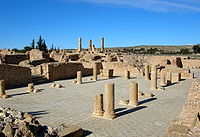
Sbeitla
Encyclopedia
Sbeitla is a small town in north-central Tunisia
. Nearby are the Roman
ruins of Sufetula, containing the best preserved Forum
temples in Tunisia. The ancient town, then held by the Byzantine
Prefect Gregory was captured by Rashidun Caliphate
's Governor of Egypt
, Abdullah ibn Saad
and his General Abd-Allah ibn al-Zubayr
in 647AD and briefly served as capital of Ifriqiya
.
.

 The region was inhabited by nomadic tribes until the Legio III Augusta
The region was inhabited by nomadic tribes until the Legio III Augusta
established a camp at Ammaedara. Through the surrender of the Berber
leader Tacfarinas
the region was pacified and populated under the Emperor Vespasian and his sons between 67 and 69.
Some inscriptions found in the city suggest that the settlement had success along the lines of others in North Africa
during the 2nd century, reaching great prosperity through the olive
industry, whose cultivation benefited from excellent climatic conditions in the region. The olive presses found in the ruins of the city further bolster this conclusion. The resulting prosperity made possible the construction of a splendid forum and other important buildings.
The city began to decline during the Late Empire, during which the city was surrounded and occupied by Vandals
, a fact that is demonstrated by the appearance of temples dedicated to the barbarian gods.
The arrival of the Byzantines inaugurated a new period of splendor. The Prefect Gregory moved his capital there from Carthage
in the seventh century, and declared independence from Byzantium
. However, only a year later the city was sacked by the first Arab
invaders, and Gregory was killed.
The Arabs abandoned the city and established Kairouan
as the new capital for North Africa.
 The majority of the Byzantine buildings take advantage of the foundations of earlier Roman ones. They include:
The majority of the Byzantine buildings take advantage of the foundations of earlier Roman ones. They include:
Tunisia
Tunisia , officially the Tunisian RepublicThe long name of Tunisia in other languages used in the country is: , is the northernmost country in Africa. It is a Maghreb country and is bordered by Algeria to the west, Libya to the southeast, and the Mediterranean Sea to the north and east. Its area...
. Nearby are the Roman
Ancient Rome
Ancient Rome was a thriving civilization that grew on the Italian Peninsula as early as the 8th century BC. Located along the Mediterranean Sea and centered on the city of Rome, it expanded to one of the largest empires in the ancient world....
ruins of Sufetula, containing the best preserved Forum
Forum (Roman)
A forum was a public square in a Roman municipium, or any civitas, reserved primarily for the vending of goods; i.e., a marketplace, along with the buildings used for shops and the stoas used for open stalls...
temples in Tunisia. The ancient town, then held by the Byzantine
Byzantine Empire
The Byzantine Empire was the Eastern Roman Empire during the periods of Late Antiquity and the Middle Ages, centred on the capital of Constantinople. Known simply as the Roman Empire or Romania to its inhabitants and neighbours, the Empire was the direct continuation of the Ancient Roman State...
Prefect Gregory was captured by Rashidun Caliphate
Rashidun Caliphate
The Rashidun Caliphate , comprising the first four caliphs in Islam's history, was founded after Muhammad's death in 632, Year 10 A.H.. At its height, the Caliphate extended from the Arabian Peninsula, to the Levant, Caucasus and North Africa in the west, to the Iranian highlands and Central Asia...
's Governor of Egypt
Egypt
Egypt , officially the Arab Republic of Egypt, Arabic: , is a country mainly in North Africa, with the Sinai Peninsula forming a land bridge in Southwest Asia. Egypt is thus a transcontinental country, and a major power in Africa, the Mediterranean Basin, the Middle East and the Muslim world...
, Abdullah ibn Saad
Abdullah ibn Saad
‘Abdullāh ibn Sa‘ad ibn Abī as-Sarḥ was the foster brother of Uthman. His father was Saad ibn Abi Sarh. Abdullah bin Sa'ad bin Abi'l Sarh built a strong Egyptian Arab navy. Under him the Muslim navy won a number of naval victories including its first major naval battle against Constans II at...
and his General Abd-Allah ibn al-Zubayr
Abd-Allah ibn al-Zubayr
`Abd Allah al-Zubayr or ibn Zubayr 624 - 692) was an Arab sahabi whose father was Zubayr ibn al-Awwam, and whose mother was Asma bint Abi Bakr, daughter of the first Caliph Abu Bakr. He was the nephew of Aisha, Prophet Muhammad's third wife....
in 647AD and briefly served as capital of Ifriqiya
Ifriqiya
In medieval history, Ifriqiya or Ifriqiyah was the area comprising the coastal regions of what are today western Libya, Tunisia, and eastern Algeria. This area included what had been the Roman province of Africa, whose name it inherited....
.
History
The oldest traces of civilization in the zone are Punic megaliths and funereal stelaStele
A stele , also stela , is a stone or wooden slab, generally taller than it is wide, erected for funerals or commemorative purposes, most usually decorated with the names and titles of the deceased or living — inscribed, carved in relief , or painted onto the slab...
.


Legio III Augusta
Legio tertia Augusta was raised in the year 43 BCE most likely by the consul Gaius Vibius Pansa and the emperor Augustus who served the Roman Empire in North Africa until at least the late 4th century CE. It is possible that it fought in the battle of Philippi against the murderers of Caesar...
established a camp at Ammaedara. Through the surrender of the Berber
Berber people
Berbers are the indigenous peoples of North Africa west of the Nile Valley. They are continuously distributed from the Atlantic to the Siwa oasis, in Egypt, and from the Mediterranean to the Niger River. Historically they spoke the Berber language or varieties of it, which together form a branch...
leader Tacfarinas
Tacfarinas
Tacfarinas was a Numidian deserter from the Roman army who led his own Musulamii tribe and a loose and changing coalition of other Ancient Libyan tribes in a war against the Romans in North Africa during the rule of emperor Tiberius .Although Tacfarinas' personal motivation is unknown, it is...
the region was pacified and populated under the Emperor Vespasian and his sons between 67 and 69.
Some inscriptions found in the city suggest that the settlement had success along the lines of others in North Africa
North Africa
North Africa or Northern Africa is the northernmost region of the African continent, linked by the Sahara to Sub-Saharan Africa. Geopolitically, the United Nations definition of Northern Africa includes eight countries or territories; Algeria, Egypt, Libya, Morocco, South Sudan, Sudan, Tunisia, and...
during the 2nd century, reaching great prosperity through the olive
Olive
The olive , Olea europaea), is a species of a small tree in the family Oleaceae, native to the coastal areas of the eastern Mediterranean Basin as well as northern Iran at the south end of the Caspian Sea.Its fruit, also called the olive, is of major agricultural importance in the...
industry, whose cultivation benefited from excellent climatic conditions in the region. The olive presses found in the ruins of the city further bolster this conclusion. The resulting prosperity made possible the construction of a splendid forum and other important buildings.
The city began to decline during the Late Empire, during which the city was surrounded and occupied by Vandals
Vandals
The Vandals were an East Germanic tribe that entered the late Roman Empire during the 5th century. The Vandals under king Genseric entered Africa in 429 and by 439 established a kingdom which included the Roman Africa province, besides the islands of Sicily, Corsica, Sardinia and the Balearics....
, a fact that is demonstrated by the appearance of temples dedicated to the barbarian gods.
The arrival of the Byzantines inaugurated a new period of splendor. The Prefect Gregory moved his capital there from Carthage
Carthage
Carthage , implying it was a 'new Tyre') is a major urban centre that has existed for nearly 3,000 years on the Gulf of Tunis, developing from a Phoenician colony of the 1st millennium BC...
in the seventh century, and declared independence from Byzantium
Byzantium
Byzantium was an ancient Greek city, founded by Greek colonists from Megara in 667 BC and named after their king Byzas . The name Byzantium is a Latinization of the original name Byzantion...
. However, only a year later the city was sacked by the first Arab
Arab
Arab people, also known as Arabs , are a panethnicity primarily living in the Arab world, which is located in Western Asia and North Africa. They are identified as such on one or more of genealogical, linguistic, or cultural grounds, with tribal affiliations, and intra-tribal relationships playing...
invaders, and Gregory was killed.
The Arabs abandoned the city and established Kairouan
Kairouan
Kairouan , also known as Kirwan or al-Qayrawan , is the capital of the Kairouan Governorate in Tunisia. Referred to as the Islamic Cultural Capital, it is a UNESCO World Heritage site. The city was founded by the Arabs around 670...
as the new capital for North Africa.
Roman remains
- The Triumphal Arch of the Tetrarchy at the entrance to the city commemorates the four emperors that governed the empire in the year 300, just before the rule of Constantine I
- The Public Baths
- The Forum is one of the best preserved in the world
- The Gate of Antoninus, which stands at the entrance to the forum and can be dated between 138 and 161. Its inscriptions make reference to Antonius Pius and his two adopted sons, Lucius VerusLucius VerusLucius Verus , was Roman co-emperor with Marcus Aurelius, from 161 until his death.-Early life and career:Lucius Verus was the first born son to Avidia Plautia and Lucius Aelius Verus Caesar, the first adopted son and heir of Roman Emperor Hadrian . He was born and raised in Rome...
and Marcus Aurelius - The three temples. In place of constructing only one temple dedicated to the three most important Roman gods (JupiterJupiter (mythology)In ancient Roman religion and myth, Jupiter or Jove is the king of the gods, and the god of the sky and thunder. He is the equivalent of Zeus in the Greek pantheon....
, JunoJuno (mythology)Juno is an ancient Roman goddess, the protector and special counselor of the state. She is a daughter of Saturn and sister of the chief god Jupiter and the mother of Mars and Vulcan. Juno also looked after the women of Rome. Her Greek equivalent is Hera...
, and MinervaMinervaMinerva was the Roman goddess whom Romans from the 2nd century BC onwards equated with the Greek goddess Athena. She was the virgin goddess of poetry, medicine, wisdom, commerce, weaving, crafts, magic...
) the inhabitants of the city built separate temples for each one. A similar arrangement is only found at Baelo ClaudiaBaelo ClaudiaBaelo Claudia is the name of an ancient Roman town, located outside of Tarifa, near the village of Bolonia, in southern Spain. Lying on the shores of the Straits of Gibraltar, the town was originally a fishing village and trade link when it was settled some 2,000 years ago...
, in SpainSpainSpain , officially the Kingdom of Spain languages]] under the European Charter for Regional or Minority Languages. In each of these, Spain's official name is as follows:;;;;;;), is a country and member state of the European Union located in southwestern Europe on the Iberian Peninsula...
. - Other important buildings include the theater and the public fountains.
Byzantine remains

- The church of Bellator
- The church of Vitalis
- The chapel of Jucundus
- The church of Servus
- The church of St Gervase, Protase, and Tryphon.

